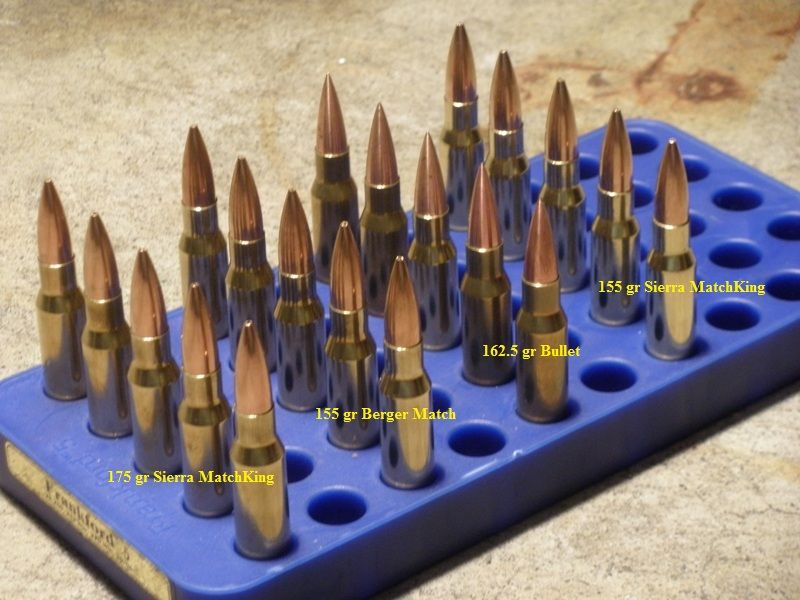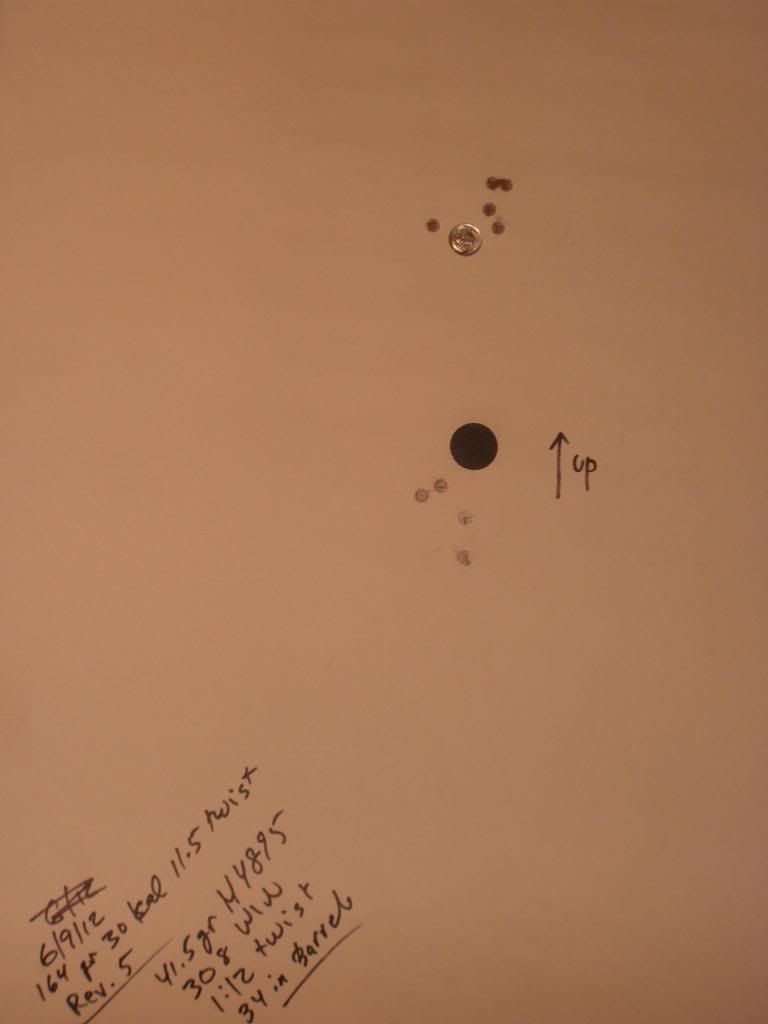Re: $1 per bullet and a free set of scope rings
So here is the additional information I promised yesterday.
I posed this question to everyone because of a very specific bullet.
Since about April of this year, I've been working towards the development of high performance target bullets with a Hide member who has a PhD in numerical methods as well as in depth knowledge of aerodynamics. Here is a picture showing our latest development.
Figure 1: Loaded 308 rounds with various bullets
Shown in Figure 1 are some loaded 308 Win rounds with a few different bullets. Closest to the camera are loaded 175 gr Sierra MatchKings, moving rearward, you have 155 gr Berger Match, the new 162.5 gr bullet, and finally 155 gr Sierra MatchKings. All loaded rounds have a COAL of 2.800”
This new 162.5 gr bullet is pretty cool. It was designed specifically for slower twist 308 rifles. Here is a list of all the good qualities of the bullet:
• The bullet weighs 162.5 gr
• It requires no special chambering considerations
• It needs only a 11.5 twist, or faster, to stabilize
• It has an averaged G1 BC of 0.565
• It is very tolerant of long throats (i.e. it jumps to the lands well)
• It is lead free
• Does not foul your barrel
• Achieves muzzle velocities of lighter, lead cored bullets
The downside is the price of the bullet. Due to the price of copper, the CNC equipment required to make the bullet, and the company's overhead and margins, a realistic retail price for the bullet is about $1. Hence the question that started this thread.
In regards to accuracy potential, here is a picture of a four and five round group recently shot at 300 yards.
Figure 2: 300 yard group
The target shown in Figure 2 was shot using my RPA prone rifle built by Jim Cloward of Lake Stevens, WA. Chambered 308 Win, I used this rifle to shoot NRA High-power competition back when I had time, and a life.
I'd like to respond to certain comments left by some members who kindly participated in this thread.
<div class="ubbcode-block"><div class="ubbcode-header">Originally Posted By: George63</div><div class="ubbcode-body">no, technology is not that backwards that some hidden trick could increase BC by 20% without adverse effects (instability) negating any advantage
when real testing occurred (like that done this spring on the 338 turned solid projectiles with the high claims/prices) the initial buyers would almost certainly be left holding the bags of their overpriced/ underperforming projectiles and looking the fool </div></div>
<div class="ubbcode-block"><div class="ubbcode-header">Originally Posted By: gstaylorg</div><div class="ubbcode-body">As I see it, there probably <span style="font-style: italic">would</span> be those willing to pay $1 per bullet if, in fact, the 20% increase in BC were demonstrably true. Perhaps not many initially, but some.
The real question in my mind would be what is different about this projectile to give a 20% increase in BC, and what would that mean as far as reloading. A 20% gain in BC would be great, right up to the point you realized you needed a faster twist rate, different chamber specs, or it was extremely difficult to produce an accurate reload due to some inherent difference in the shape of the projectile required to get the higher BC. If that turned out to be the case, IMO such a projectile wouldn't be worth the cost, even if they were priced similarly to the others you mentioned.
On the other hand, I would be willing to bet that if all else were equal (ease of reloading, twist rate, chamber specs, etc.), a projectile that performed as described would find a large market quickly as the word got around. Unfortunately, there's really no way to gauge its potential without significantly more information than simply a 20% increase in BC. </div></div>
<div class="ubbcode-block"><div class="ubbcode-header">Originally Posted By: skog</div><div class="ubbcode-body">No, I would not pay 2x-3x more for a bullet with a 20% gain. The way I see it is why shoot a 308 that has the ballistics of a 300 win mag that cost more than a 300 win mag with traditional bullets. Also what special requirements would this bullet require with twist rate and chambers? </div></div>
The BC of this projectile is real. The BC was verified using a <span style="text-decoration: underline"><span style="font-style: italic"><span style="font-weight: bold">properly</span></span></span> designed drop test so the 0.565 number is not an estimate like those published by other manufacturers. It is a measured value. The bullet has a high BC and is stable from a relatively slow twist, commonly available barrel without special requirements.
<div class="ubbcode-block"><div class="ubbcode-header">Originally Posted By: 71firebird400</div><div class="ubbcode-body">No, and I don't think many others would either. Just look at the current market share; not everyone shops bullets by BC- they're looking at things like cost and how finicky a bullet can be. In my experience, as BC goes up so does how picky the bullet is to load for. Berger's are already pushing the envelope for cost, so I really don't think an even more expensive bullet would be a good seller. </div></div>
This bullet has a high BC and is definitely not finicky to load for. It does not show the seating depth dependence like some other, very secant bullets do.
<div class="ubbcode-block"><div class="ubbcode-header">Originally Posted By: Steelhead</div><div class="ubbcode-body">I ran the numbers through my ballistic calculator and found this:
Elevation at 1000 yards gives you slightly better than 10% reduction in elevation adjustment. (32.9 moa to 29.5 moa)
Not that big of a deal.
However, if you look at windage, then you gain just over 25% better recuction in adjustment. (7.5 moa vs 5.9 moa)
In the computer model, it looks like the bullet would effectively mimic my 6.5 Creedmoor load. Of course real world testing would need to be done to verify. Interestingly the .30 cal load would beat my 6mm Creedmoor load in windage, but not elevation.
What is really impressive is the amount of energy that is retained with the 20% better bullet. 942 ft/lbs compared to 728 ft/lbs.</div></div>
I encourage you to run the numbers again. This time use the 0.565 BC, 162.5gr weight, and a faster muzzle velocity than a standard 175 gr projectile. You will find the wind difference is pretty substantial.
<div class="ubbcode-block"><div class="ubbcode-header">Originally Posted By: Will</div><div class="ubbcode-body">NO, not in 30 cal. can't be that much advantage. Will stick with Lapua 185 or Berger 175 </div></div>
Use a ballistic calculator and you will find that these bullets offer a significant advantage. Below is a wind drift comparison between 175 SMK and this new 162.5 grain bullet. At 1000 yards, wind drift for the 162.5 is 30% less than that of the 175 SMK. That's significant.
Figure 3: Wind Drift Comparison
<div class="ubbcode-block"><div class="ubbcode-header">Originally Posted By: Red_SC</div><div class="ubbcode-body">I'll be different. Assuming the accuracy was there, I'd shoot some in matches on shots where the wind is unusually difficult- shooting Herman at the Practical Marksman comes immediately to mind. 1100+ yards, odd swirling winds, and .308 only- yeah, I'd pay a dollar. It wouldn't replace my primary load though. </div></div>
This is exactly what these bullets are designed for.
<div class="ubbcode-block"><div class="ubbcode-header">Originally Posted By: Sirhrmechanic</div><div class="ubbcode-body">But I would pay a premium for a .50 bmg with a significantly better BC than anything else out there... If you have a design that would scale to the BMG, definitely interested. Of course, they would be more than $1 each ;-)
</div></div>
We certainly have considered making these bullets in larger calibers where similar gains in performance can be had. However, for the same reasons mentioned above, the price of these larger bullets would be even higher. 33 caliber bullets would be priced around $1.80 each, 37 cal at around $2.25 each, and 50 cal at around $4 each.
So, thoughts?





